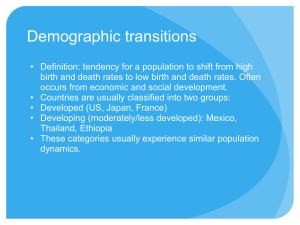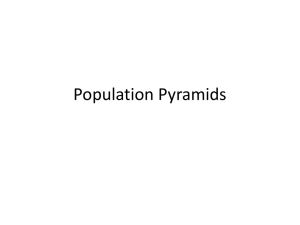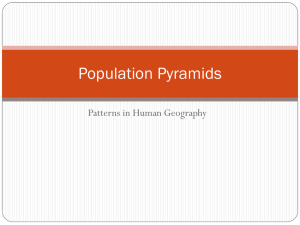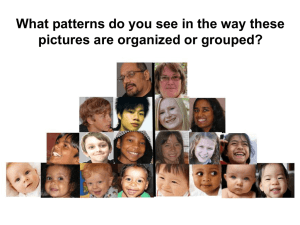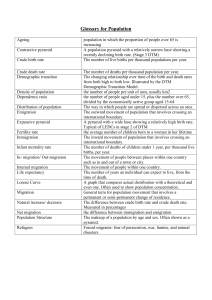Population Pyramids Lab
advertisement
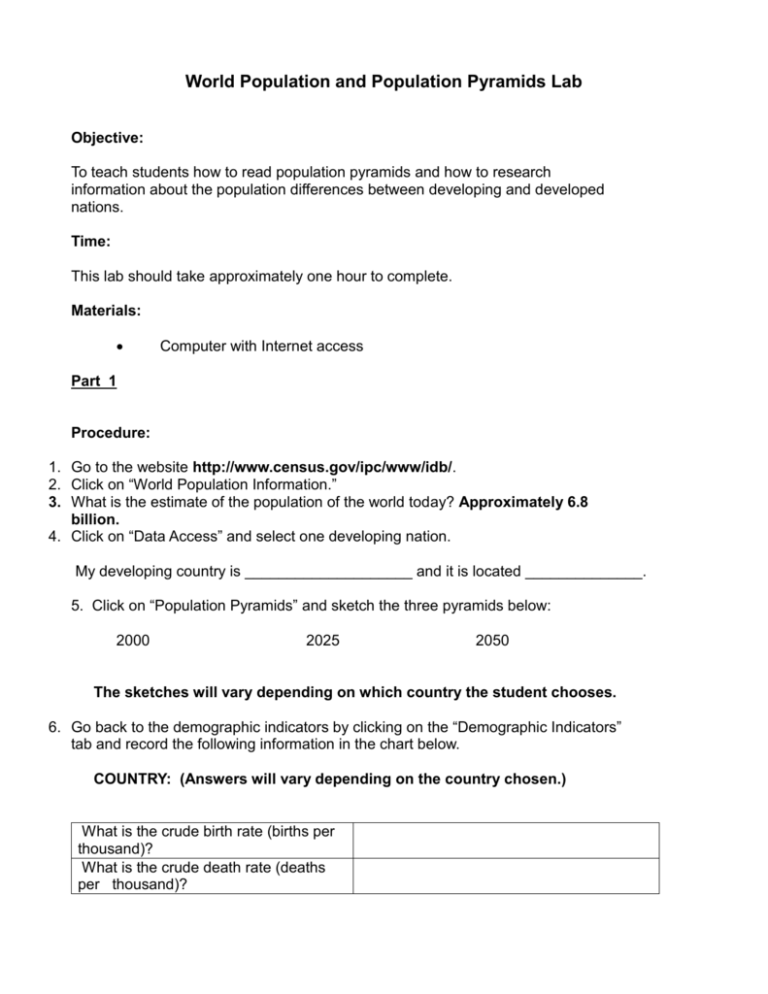
World Population and Population Pyramids Lab Objective: To teach students how to read population pyramids and how to research information about the population differences between developing and developed nations. Time: This lab should take approximately one hour to complete. Materials: Computer with Internet access Part 1 Procedure: 1. Go to the website http://www.census.gov/ipc/www/idb/. 2. Click on “World Population Information.” 3. What is the estimate of the population of the world today? Approximately 6.8 billion. 4. Click on “Data Access” and select one developing nation. My developing country is ____________________ and it is located ______________. 5. Click on “Population Pyramids” and sketch the three pyramids below: 2000 2025 2050 The sketches will vary depending on which country the student chooses. 6. Go back to the demographic indicators by clicking on the “Demographic Indicators” tab and record the following information in the chart below. COUNTRY: (Answers will vary depending on the country chosen.) What is the crude birth rate (births per thousand)? What is the crude death rate (deaths per thousand)? What is the life expectancy at birth? What is the infant mortality rate? What is the total fertility rate? What is the net number of migrants? Analysis: 1. What can you tell about your country’s growth rate by looking at your histogram (population pyramid)? Answers could include that the country is rapidly growing because of the large base of the pyramid. 2. If the birth and death rates remain the same as they are today, what will your pyramid look like in 25 years? The country will have an even broader pyramid shape. 3. What are some factors that could change the shape of your pyramid? Industrialization, baby boom, infant mortality, birth control, government control of population numbers, etc., could all change the shape of the pyramid. 4. Determine the percentage of the population that has not yet reached childbearing age. What does this number say about the prospects for future growth? This will depend on which country the student chose. 5. If your country’s population growth rate is not increasing, what are some socioeconomic problems that might occur? There will not be any younger people to work or pay taxes and the country’s economic system could be in jeopardy. 6. Does your country have a baby boom (a bulge somewhere in the middle of it)? What could account for this? This will depend on which country the student chooses. Possible answers include war, natural disaster, less disease as a population moves through the demographic transition, etc. 7. If you had a business and you wanted to capitalize on your information about the population age distribution, what would you sell and why? If the country has a lot of babies, for example, the business would sell baby diapers, bottles, cribs, pacifiers, strollers, etc. 8. Is your country increasing in size, decreasing in size, or close to ZPG (zero population growth)? This country is increasing in size. (There are a few cases where a developing country is not increasing in size, so this answer could vary depending on the country the student chooses.) Part 2 Procedure: Repeat the entire procedure using a developed nation. My developed country is _______________________ and it is located ________________. 1. Sketch the three pyramids below: 2000 2025 2050 The sketches will vary depending on which country the student chooses. 2. Now click on “Demographic Indicators.” Once again select your country. Record the following information in the chart below. COUNTRY: (Answers will vary depending on the country chosen.) What is the crude birth rate (births per thousand)? What is the crude death rate (deaths per thousand)? What is the life expectancy at birth? What is the infant mortality rate? What is the total fertility rate? What is the net number of migrants? Analysis: 1. What can you tell about your country’s growth rate by looking at your histogram (population pyramid)? The country is either stable or decreasing in size depending on the specific country the student chooses. 2. If the birth and death rates remain the same as they are today, what will your pyramid look like in 25 years? The pyramid will be box-like or an inverted pyramid. 3. What are some factors that could change the shape of your pyramid? Industrialization, baby boom, infant mortality, birth control, government control of population numbers, etc., could all change the shape of the pyramid. 4. Determine the percentage of the population that has not yet reached childbearing age. What does this number say about the prospects for future growth? This will depend on which country the student chooses. 5. If your country’s population growth rate is not increasing, what are some socioeconomic problems that might occur? There will not be any younger people to work or pay taxes and the country’s economic system could be in jeopardy. 6. Does your country have a baby boom (a bulge somewhere in the middle of it)? What could account for this? This will depend on which country the student chooses. Possible answers include war, natural disaster, less disease as a population moves through the demographic transition, etc. 7. If you had a business and you wanted to capitalize on your information about the population age distribution, what would you sell and why? This country will have either an equal number of all age groups or a larger number of older people. For an equal number of all age groups, the business could sell houses, cars, life/health insurance, or food. If the country has a large number of elderly people, it could sell walkers, nursing homes, dentures, etc. 8. Is your country increasing in size, decreasing in size, or close to ZPG (zero population growth)? A country with a box-like pyramid is in ZPG (zero population growth); an inverted pyramid indicates that the country is decreasing in size.
